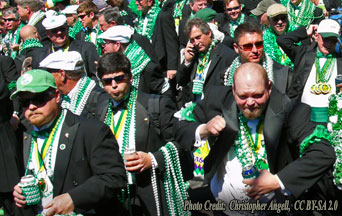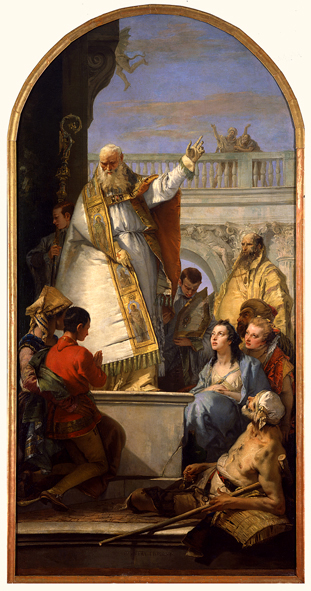
It seems that every year has a new controversy over Saint Patrick’s Day. First, the feast was reduced to a mere cultural festival. Later, drunkenness marred the feast, then participation of homosexual groups in parades. Now the feast is politicized by politicians who are using the occasion to assert their pro-abortion and LGBT agenda. Saint Patrick, the scourge of the pagan Druids, needs to return to set things straight.
The traditional Catholic view is that Saint Patrick’s Day is a feast day in remembrance of a great saint, the Patron of Ireland. According to the Catholic Encyclopedia, such days have a specific purpose:
Feast Days, or Holy Days, are days which are celebrated in commemoration of the sacred mysteries and events recorded in the history of our redemption, in memory of the Virgin Mother of Christ, or of His apostles, martyrs, and saints, by special services and rest from work. A feast not only commemorates an event or person, but also serves to excite the spiritual life by reminding us of the event it commemorates. (Emphasis added.)
Thus, the Church intends the seventeenth of March to be a day to reflect upon the virtues of Saint Patrick and his achievements—specifically bringing Christianity to the Irish.
All of which begs the question, how would Saint Patrick see today’s Saint Patrick’s Day? In an attempt to answer that question intelligently, it is necessary to briefly examine his life, how his celebration became popular in the U.S. and the process of his feast’s degenerations.
The Real Saint Patrick
Patrick was born into a well-off Scots family about A.D. 386. One of his mother’s relatives is believed to have been Saint Martin of Tours. However, Patrick himself confessed that he “did not know the true God” as a young person. At age sixteen, he was abducted, transported into Ireland, and sold into slavery. It was as a slave to a Druid master that Patrick devoted himself to God.

Patrick escaped after six years of slavery. Eventually, he made his way to France, where he joined the Church, studied, and was ordained a Deacon about 418. Fourteen years later, he was consecrated as a Bishop and sent by Pope Celestine I to Ireland to convert the population to Christianity.
Over the remaining decades of his life, Patrick successfully planted Christianity in Ireland, by challenging and completely defeating the pagan Druid culture. He also established parishes and dioceses and founded monasteries. According to legend, he gained the confidence of the Irish by driving all snakes from the island. Most sources say that he died in 461.
An Old World Saint in the New World
Saint Patrick crossed the Atlantic with the first Irish settlers sometime before the American Revolution. The first Saint Patrick’s Day parade in New York City was held in 1762. By the early nineteenth century, several Catholic churches bore Saint Patrick’s name, including New York’s first cathedral—whose cornerstone was laid in 1808.
However, the transformation of Saint Patrick’s Day began with the mass immigration of the “Famine Irish” in the eighteen-forties. The story of Patrick’s abduction and sale into slavery resonated with those who had been torn from their own country. The great saint’s victories over Druidism inspired people who had to chart their own path in a new nation dominated by Protestants. March 17 became a day of general celebration and connection for the residents of the most Irish city in the world—New York City’s Irish community of 200,000 in 1860 being larger than the entire population of Dublin.
A Catholic Holiday?
As the political influence of the Irish grew, so did the importance of their great feast. Gradually Catholics of other nationalities joined in the celebration. After 1900, marriage between the Irish and other Catholic nationalities became increasingly common, so it was no longer unusual to see the La Portes, the Schmidts, or the Rossis celebrating the day with as much verve as the Flynns and the MacNamaras.
Gradually, the day lost much of its Catholic flavor. Parishes named for the great Irish saint continued to host corned beef and cabbage dinners, but these were generally more dignified and less popular than the celebrations at the Irish-owned corner bar. About the turn of the twentieth century, celebratory cards and other images began to be printed. They tended to feature shamrocks, children, Irish dance, and similar themes. Very few of them, however, actually include Saint Patrick.
 Learn All About the Prophecies of Our Lady of Good Success About Our Times
Learn All About the Prophecies of Our Lady of Good Success About Our Times
By 1930, teachers in public schools with negligible Irish populations were as likely to hang shamrocks on the walls as those who taught at Saint Patrick’s or Saint Columba’s parish schools. Participation in the many local Saint Patrick’s Day parades was no longer limited to Catholics or those of Irish heritage.
A Day of Decadent Revelry
Increasingly, the celebration of Saint Patrick’s Day boiled down to two activities, parades and drinking. Producers of beverages found success in marketing alcohol linked to Saint Patrick’s Day. According to figures from the National Retail Federation, 51.2% of adult Americans will celebrate the holiday—and over half of them will attend a party in a bar or restaurant. It is a safe assumption that very few of those adults intend to discuss the virtues and achievements of Ireland’s patron saint.
A Megaphone for Anti-Catholic Causes
As the focus on Saint Patrick deteriorated, the public parades soon became a part of the culture war as platforms for immodesty, immorality and homosexuality. The turning point was in September 2014, when New York’s parade committee announced that “The Lavender and Green Alliance,” a homosexual group, would be allowed to march in the 2015 parade. Committee Vice-Chairman John L. Lahey said that the decision to include groups of homosexuals was “a gesture of goodwill to the LGBT community, all the while remaining loyal to Church teachings and principles that have guided the parade committee for so many decades.” New York’s Cardinal Timothy Dolan, who could veto the decision, was quoted as saying that the parade organization, “continues to have my confidence and support.” True to form, Cardinal Dolan smiled as he fulfilled his role as Grand Marshal of that parade.
10 Razones Por las Cuales el “Matrimonio” Homosexual es Dañino y tiene que Ser Desaprobado
In nearby Queens, the community of Throggs Neck hosts its own festivities. This year, they will begin with Holy Mass at 9:00 a.m. followed by a community breakfast and then a parade at noon. The parade’s 2019 Grand Marshal will be the neighborhood’s former congressman, Joe Crowley. Before Rep. Crowley’s defeat at the hands of Alexandria Ocasio-Cortez, he accumulated a voting record that earned him a 100% endorsement by the National Abortion Rights Action League (NARAL) and a 0% rating by the National Right to Life Committee. Rep. Crowley was also a vocal supporter of homosexual “marriage” and “Medicare for All” (one of the more recent euphemisms for socialized medicine).
In 2019, members of the extremely liberal Irish government will fan out around the United States to celebrate the day. Prime Minister Leo Varadkar, an avowed homosexual, will visit the White House, his Health Minister will march in New York’s parade. The Minister of State for Equality, Immigration, and Integration will be in Atlanta. Other government members will visit Boston, Austin, Denver, and Seattle.
The Return of the Druids in Ireland
Prime Minister Varadkar changed his Pro-Life position and supported abortion-on-demand in Ireland. By the summer of 2018, he took part in a Dublin rally celebrating the victory of pro-abortion forces. A National Review article quotes him as being willing to force Catholic hospitals to provide abortions when he said, “But it will not be possible for publicly funded hospitals, no matter who their patron or owner is, to opt out of providing these necessary services, which will be legal in the state once the legislation is passed by the Dáil and the Seanad [the two houses of the Irish legislature].”
What Would Saint Patrick Say?
In his confession, Saint Patrick said,
I do not trust myself as long as I am in this body of death, for strong is he who daily strives to turn me away from the faith and the purity of true religion to which I have devoted myself…. But the hostile flesh is ever dragging us unto death, that is, towards the forbidden satisfaction of one’s desires… up to now, thanks to the grace of God, I have kept the faith.
For far too many, Saint Patrick’s Day has ceased to be a day to commemorate the life of a great and courageous defender of the faith. It has become a day to celebrate once again the barbaric practices of the ancient Druids who were said to have practiced human sacrifice. Faithful Catholics must turn to Our Lord and Our Lady requesting that Saint Patrick’s Day live up to the example of the great bishop. Saint Patrick must return and will drive away the new “snakes” in the form of modern errors away from America’s shores.

